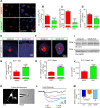Calcineurin/NFAT Signaling in Activated Astrocytes Drives Network Hyperexcitability in Aβ-Bearing Mice
- PMID: 28559377
- PMCID: PMC5481945
- DOI: 10.1523/JNEUROSCI.0877-17.2017
Calcineurin/NFAT Signaling in Activated Astrocytes Drives Network Hyperexcitability in Aβ-Bearing Mice
Abstract
Hyperexcitable neuronal networks are mechanistically linked to the pathologic and clinical features of Alzheimer's disease (AD). Astrocytes are a primary defense against hyperexcitability, but their functional phenotype during AD is poorly understood. Here, we found that activated astrocytes in the 5xFAD mouse model were strongly associated with proteolysis of the protein phosphatase calcineurin (CN) and the elevated expression of the CN-dependent transcription factor nuclear factor of activated T cells 4 (NFAT4). Intrahippocampal injections of adeno-associated virus vectors containing the astrocyte-specific promoter Gfa2 and the NFAT inhibitory peptide VIVIT reduced signs of glutamate-mediated hyperexcitability in 5xFAD mice, measured in vivo with microelectrode arrays and ex vivo brain slices, using whole-cell voltage clamp. VIVIT treatment in 5xFAD mice led to increased expression of the astrocytic glutamate transporter GLT-1 and to attenuated changes in dendrite morphology, synaptic strength, and NMDAR-dependent responses. The results reveal astrocytic CN/NFAT4 as a key pathologic mechanism for driving glutamate dysregulation and neuronal hyperactivity during AD.SIGNIFICANCE STATEMENT Neuronal hyperexcitability and excitotoxicity are increasingly recognized as important mechanisms for neurodegeneration and dementia associated with Alzheimer's disease (AD). Astrocytes are profoundly activated during AD and may lose their capacity to regulate excitotoxic glutamate levels. Here, we show that a highly active calcineurin (CN) phosphatase fragment and its substrate transcription factor, nuclear factor of activated T cells (NFAT4), appear in astrocytes in direct proportion to the extent of astrocyte activation. The blockade of astrocytic CN/NFAT signaling in a common mouse model of AD, using adeno-associated virus vectors normalized glutamate signaling dynamics, increased astrocytic glutamate transporter levels and alleviated multiple signs of neuronal hyperexcitability. The results suggest that astrocyte activation drives hyperexcitability during AD through a mechanism involving aberrant CN/NFAT signaling and impaired glutamate transport.
Keywords: Alzheimer's disease; astrocytes; calcineurin; dementia; glutamate; hyperexcitability.
Copyright © 2017 the authors 0270-6474/17/376132-17$15.00/0.
Figures







Similar articles
-
Blockade of Astrocytic Calcineurin/NFAT Signaling Helps to Normalize Hippocampal Synaptic Function and Plasticity in a Rat Model of Traumatic Brain Injury.J Neurosci. 2016 Feb 3;36(5):1502-15. doi: 10.1523/JNEUROSCI.1930-15.2016. J Neurosci. 2016. PMID: 26843634 Free PMC article.
-
Cognitive decline in Alzheimer's disease is associated with selective changes in calcineurin/NFAT signaling.J Neurosci. 2009 Oct 14;29(41):12957-69. doi: 10.1523/JNEUROSCI.1064-09.2009. J Neurosci. 2009. PMID: 19828810 Free PMC article.
-
Interleukin-1beta-dependent signaling between astrocytes and neurons depends critically on astrocytic calcineurin/NFAT activity.J Biol Chem. 2008 Aug 8;283(32):21953-64. doi: 10.1074/jbc.M800148200. Epub 2008 Jun 9. J Biol Chem. 2008. PMID: 18541537 Free PMC article.
-
Targeting CaN/NFAT in Alzheimer's brain degeneration.Front Immunol. 2023 Nov 23;14:1281882. doi: 10.3389/fimmu.2023.1281882. eCollection 2023. Front Immunol. 2023. PMID: 38077352 Free PMC article. Review.
-
Astrocyte Activation and the Calcineurin/NFAT Pathway in Cerebrovascular Disease.Front Aging Neurosci. 2018 Sep 21;10:287. doi: 10.3389/fnagi.2018.00287. eCollection 2018. Front Aging Neurosci. 2018. PMID: 30297999 Free PMC article. Review.
Cited by
-
Calcineurin Signalling in Astrocytes: From Pathology to Physiology and Control of Neuronal Functions.Neurochem Res. 2023 Apr;48(4):1077-1090. doi: 10.1007/s11064-022-03744-4. Epub 2022 Sep 9. Neurochem Res. 2023. PMID: 36083398 Free PMC article. Review.
-
Astrocytes: Heterogeneous and Dynamic Phenotypes in Neurodegeneration and Innate Immunity.Neuroscientist. 2019 Oct;25(5):455-474. doi: 10.1177/1073858418809941. Epub 2018 Nov 17. Neuroscientist. 2019. PMID: 30451065 Free PMC article. Review.
-
An emerging role of astrocytes in vascular contributions to cognitive impairment and dementia.J Neurochem. 2018 Mar;144(5):644-650. doi: 10.1111/jnc.14273. Epub 2018 Jan 22. J Neurochem. 2018. PMID: 29222909 Free PMC article. Review.
-
Parallel electrophysiological abnormalities due to COVID-19 infection and to Alzheimer's disease and related dementia.Alzheimers Dement. 2024 Oct;20(10):7296-7319. doi: 10.1002/alz.14089. Epub 2024 Aug 29. Alzheimers Dement. 2024. PMID: 39206795 Free PMC article.
-
Age-Related Brain Atrophy and the Positive Effects of Behavioral Enrichment in Middle-Aged Beagles.J Neurosci. 2024 May 15;44(20):e2366232024. doi: 10.1523/JNEUROSCI.2366-23.2024. J Neurosci. 2024. PMID: 38561226 Free PMC article.
References
-
- Abdul HM, Sama MA, Furman JL, Mathis DM, Beckett TL, Weidner AM, Patel ES, Baig I, Murphy MP, LeVine H 3rd, Kraner SD, Norris CM (2009) Cognitive decline in Alzheimer's disease is associated with selective changes in calcineurin/NFAT signaling. J Neurosci 29:12957–12969. 10.1523/JNEUROSCI.1064-09.2009 - DOI - PMC - PubMed
-
- Andreasson KI, Bachstetter AD, Colonna M, Ginhoux F, Holmes C, Lamb B, Landreth G, Lee DC, Low D, Lynch MA, Monsonego A, O'Banion MK, Pekny M, Puschmann T, Russek-Blum N, Sandusky LA, Selenica ML, Takata K, Teeling J, Town T, et al. (2016) Targeting innate immunity for neurodegenerative disorders of the central nervous system. J Neurochem 138:653–693. 10.1111/jnc.13667 - DOI - PMC - PubMed
Publication types
MeSH terms
Substances
Grants and funding
LinkOut - more resources
Full Text Sources
Other Literature Sources
Medical
Molecular Biology Databases
